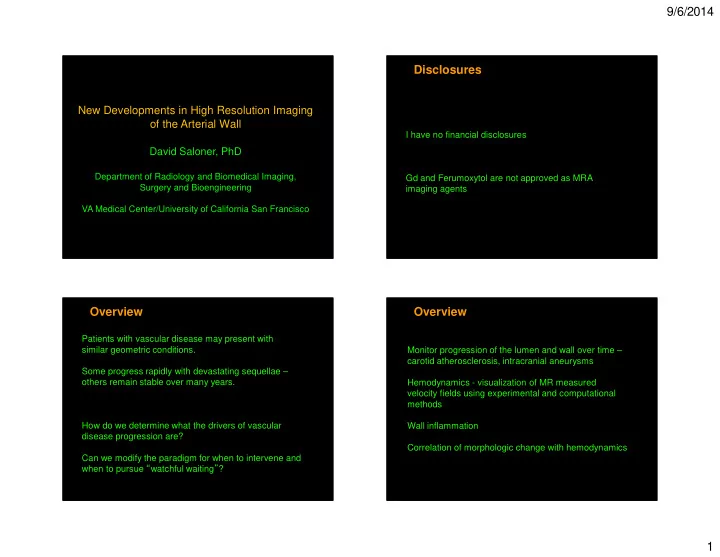

9/6/2014 Disclosures New Developments in High Resolution Imaging of the Arterial Wall I have no financial disclosures David Saloner, PhD Department of Radiology and Biomedical Imaging, Gd and Ferumoxytol are not approved as MRA Surgery and Bioengineering imaging agents VA Medical Center/University of California San Francisco Overview Overview Patients with vascular disease may present with similar geometric conditions. Monitor progression of the lumen and wall over time – carotid atherosclerosis, intracranial aneurysms Some progress rapidly with devastating sequellae – others remain stable over many years. Hemodynamics - visualization of MR measured velocity fields using experimental and computational methods How do we determine what the drivers of vascular Wall inflammation disease progression are? when to pursue “ watchful waiting ” ? Correlation of morphologic change with hemodynamics Can we modify the paradigm for when to intervene and 1
9/6/2014 Disease conditions – Carotid Atherosclerosis Current Evaluation • Traditional assessment in terms of Stenosis - reduction in diameter of lumen diameter narrowing b • Is geometry sufficient? a stenosis = (b - a)/b x 100 % � Why diameter stenosis? - because it is available Disease conditions – Carotid Atherosclerosis What is the risk factor associated with carotid disease? • Is geometry sufficient? c d b a 2
9/6/2014 High Resolution MRI ex vivo Carotid disease advantage – specimen availability from endarterectomy surgery Characterize compositional and geometric morphology – compare MR features with histo- pathologic gold standard Stenosis shape Carotid specimen Cross-section through maximal stenosis for 9 specimens 60 frequency Longitudinal MRI 50 40 30 20 10 Transverse MRI 0 circular crescentic elliptic lobular 3
9/6/2014 What is the diameter of England? High Resolution MRI In Vivo • Can we obtain similar data in vivo that will permit us to follow the progression of plaque bulk, geometry, and compositional features? • Can we identify the features of the plaque that correlate with rapid progression in a prospective fashion? • Can we identify the features of the plaque that confer neurological risk? 2D “black blood” vessel wall imaging Intraplaque hematoma Calcification clearly noted 4
9/6/2014 Reduction in measurement error – � field strength Disease conditions – Carotid Atherosclerosis T2-weighted T1-weighted 1.5T + bilateral 4-channel coils 3T + bilateral 8-channel coils Non-contrast Non-contrast – improved SNR: deep & low Is geometry & composition sufficient? fibrous cap and lipidic core T1 T2 3D Black Blood Imaging of Hemorrhage Heavily T1-weighted; sensitive to methemoglobin T2-weighted T1-weighted 3D-TOF transverse reformat coronal TOF-MRA – bright lumen reformat 5
9/6/2014 Carotid Atherosclerosis T1-weighted T2-weighted Non-contrast Non-contrast Thromboembolism from plaque rupture Pre rupture MRV Can measure velocity field in addition to Carotid Atherosclerosis structural and compositional morphology Thromboembolism from plaque rupture Pre rupture Post rupture 6
9/6/2014 Disease conditions – Carotid Atherosclerosis Disease conditions – Carotid Atherosclerosis Untreated Intracranial Aneurysms Disease conditions – Carotid Atherosclerosis Ruptured aneurysms can have devastating • MR powerful non-invasive method to monitor clinical sequellae progression Untreated aneurysms can continue to remodel, • Flow limitation rarely of importance layer thrombus, or rupture • Can identify major components of plaque Little information is available on natural wall: calcification; lipid rich necrotic core; progression of untreated aneurysms intra-plaque hemorrhage; fibrous cap Role of hemodynamics in progression is • 3D methods increasingly used at 3T undefined 7
9/6/2014 Longitudinal studies: MRA co-registration Disease conditions – Intra-cranial Aneurysmal Disease Surfaces obtained from baseline and follow-up MRA • Most current analyses of growth and rupture are co-registered risk based on geometric considerations • Absolute diameter, neck/diameter ratio … • Quantitative measurement of the changes obtained by calculating the aneurysmal • Is geometry sufficient? volume at each study High Resolution Black Blood Intracranial Vessel Wall Imaging 3D SPACE – black blood vessel wall imaging Suppress blood signal and obtain contrast between outer wall and adjacent tissue 0.5mmx0.5mmx0.6mm Aneurysm growth observed Flow computed with CFD 10 mins with CE-MRA studies over time 8
9/6/2014 Patient with a giant fusiform basilar artery Patient with a giant fusiform basilar artery aneurysm with heavy thrombus burden aneurysm with heavy thrombus burden Single slice from Single slice from Single slice from Single slice from 3D – CE-MRA 3D – black blood wall imaging 3D – CE-MRA 3D – black blood wall imaging 0.5mmx0.5mmx0.6mm 0.5mmx0.5mmx0.6mm 0.7mmx0.7mmx0.7mm 0.7mmx0.7mmx0.7mm Excellent wall visualization Excellent wall visualization Subject with ica terminus aneurysm USPIO in the wall as a marker of Single slice from Single slice from inflammation? 3D – CE-MRA 3D – black blood wall imaging 0.7mmx0.7mmx0.7mm 0.5mmx0.5mmx0.6mm Scavenged by macrophage Potentially differentiate stable from active (growing) aneurysms Good wall visualization 9
9/6/2014 Aortic Dissection – stable over 10 years Aortic Dissection – stable over 10 years First pass –single slice Steady-state MIP Pre-uspio injection 5 days post true versus false lumen Aortic Dissection – rapid growth in AAA Aortic Dissection – rapid growth Single slice sagittal Single slice coronal Pre-uspio injection 5 days post Repaired TAA AAA - thrombus 10
9/6/2014 Aortic Dissection – rapid growth Intracranial Aneurysm– basilar tip 5 days post T2* weighted image of aneurysm wall at the tip of the basilar artery imaged before (left) and five days following Ferumoxytol administration (right). Uptake by inflammatory macrophage in the vessel wall (large red circle). Acknowledgments Future Directions Radiology Neurointerventional Radiology Vitaliy Rayz, PhD Randall Higashida, MD • Important to establish link to biomolecular and Chengcheng Zhu, PhD Van Halbach, MD cellular pathways that are activated by adverse Alastair Martin, PhD Chris Dowd, MD Henrik Haraldsson, PhD Steve Hetts, MD hemodynamics Farshid Farzaneh, MS Biostatistics Donne Nieuwoudt, MD Chuck McCulloch, PhD • Establish presence of inflammatory agents in Neurosurgery surgical specimens co-localized with hemodynamics Michael Lawton, MD Neurology Vascular Surgery • Improved VWI at higher field strength (7T) and Nerissa Ko, MD Joseph Rapp, MD greater resolution Wade Smith, MD Andy Josephson, MD Anthony Kim, MD Heather Fullerton, MD Funding NIH (NINDS, NHLBI), VA Merit 11
Recommend
More recommend